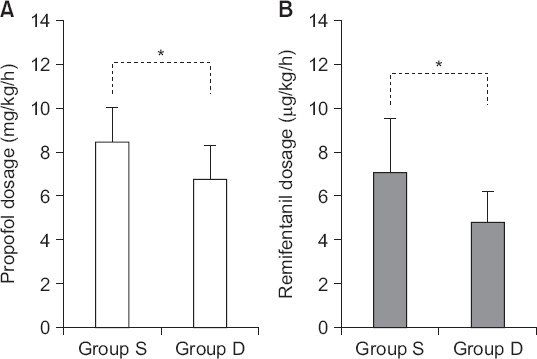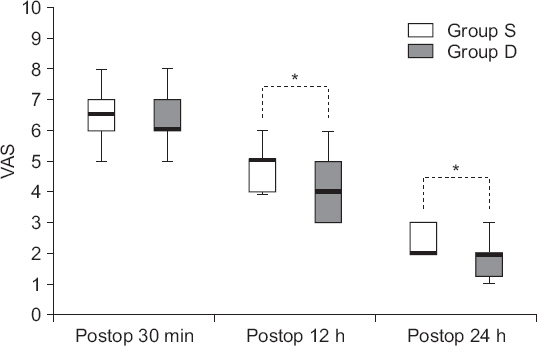Anesth Pain Med.
2019 Jan;14(1):29-34. 10.17085/apm.2019.14.1.29.
Effects of preanesthetic single administration of dexmedetomidine on the remifentanil and propofol requirement during laparoscopic cholecystectomy
- Affiliations
-
- 1Department of Anesthesiology and Pain Medicine, Eulji University Hospital, Daejeon, Korea. ryu4912@naver.com
- KMID: 2434195
- DOI: http://doi.org/10.17085/apm.2019.14.1.29
Abstract
- BACKGROUND
Dexmedetomidine, an α2-adrenergic agonist, can be used for sedation and as an adjuvant to anesthetics. This study aimed to evaluate the effects of preanesthetic administration of dexmedetomidine on the propofol and remifentanil requirement during general anesthesia and postoperative pain in patients undergoing laparoscopic cholecystectomy.
METHODS
Sixty patients were randomly assigned to group D or S (n = 30 each). Dexmedetomidine (0.5 µg/kg) and a comparable volume of saline were administered in groups D and S, respectively, over a 10 minutes period before induction. General anesthesia was induced and maintained with propofol and remifentanil; the bispectral index was maintained at 40-60. The intraoperative remifentanil and propofol dosages were recorded, and postoperative pain was assessed using a visual analog scale (VAS).
RESULTS
In groups S and D, propofol dosage was 8.52 ± 1.64 and 6.83 ± 1.55 mg/kg/h, respectively (P < 0.001), while remifentanil dosage was 7.18 ± 2.42 and 4.84 ± 1.44 µg/ kg/h, respectively (P < 0.001). VAS scores for postoperative pain were 6.50 (6-7) and 6.0 (6-7), respectively, at 30 minutes (P = 0.569), 5 (4-5) and 4 (3-5), respectively, at 12 hours (P = 0.039), and 2 (2-3) and 2 (1.25-2), respectively, at 24 hours (P = 0.044). The Friedman test revealed that VAS scores changed over time in both groups (P < 0.001).
CONCLUSIONS
Preanesthetic single administration of a low dose of dexmedetomidine (0.5 µg/kg) can significantly decrease the remifentanil and propofol requirement during short surgeries and alleviate postoperative pain.
MeSH Terms
Figure
Reference
-
1. Gertler R, Brown HC, Mitchell DH, Silvius EN. Dexmedetomidine: a novel sedative-analgesic agent. Proc (Bayl Univ Med Cent). 2001; 14:13–21. DOI: 10.1080/08998280.2001.11927725. PMID: 16369581.2. Le Guen M, Liu N, Tounou F, Augé M, Tuil O, Chazot T, et al. Dexmedetomidine reduces propofol and remifentanil requirements during bispectral index-guided closed-loop anesthesia: a double-blind, placebo-controlled trial. Anesth Analg. 2014; 118:946–55. DOI: 10.1213/ANE.0000000000000185. PMID: 24722260.3. Dutta S, Karol MD, Cohen T, Jones RM, Mant T. Effect of dexmedetomidine on propofol requirements in healthy subjects. J Pharm Sci. 2001; 90:172–81. DOI: 10.1002/1520-6017(200102)90:2<172::AID-JPS8>3.0.CO;2-J. PMID: 11169534.4. Khan ZP, Munday IT, Jones RM, Thornton C, Mant TG, Amin D. Effects of dexmedetomidine on isoflurane requirements in healthy volunteers. 1: Pharmacodynamic and pharmacokinetic interactions. Br J Anaesth. 1999; 83:372–80. DOI: 10.1093/bja/83.3.372. PMID: 10655905.5. Ohtani N, Kida K, Shoji K, Yasui Y, Masaki E. Recovery profiles from dexmedetomidine as a general anesthetic adjuvant in patients undergoing lower abdominal surgery. Anesth Analg. 2008; 107:1871–4. DOI: 10.1213/ane.0b013e3181887fcc. PMID: 19020132.6. Feld JM, Hoffman WE, Stechert MM, Hoffman IW, Ananda RC. Fentanyl or dexmedetomidine combined with desflurane for bariatric surgery. J Clin Anesth. 2006; 18:24–8. DOI: 10.1016/j.jclinane.2005.05.009. PMID: 16517328.7. Blaudszun G, Lysakowski C, Elia N, Tramèr MR. Effect of perioperative systemic α2 agonists on postoperative morphine consumption and pain intensity: systematic review and meta-analysis of randomized controlled trials. Anesthesiology. 2012; 116:1312–22. DOI: 10.1097/ALN.0b013e31825681cb. PMID: 22546966.8. Kim JW, Lee HL, Park JS, Kim JH, Ryu KH. Pre-anesthetic sedative effects of dexmedetomidine in laparoscopic cholecystectomy performed under general anesthesia. Anesth Pain Med. 2018; 13:23–9. DOI: 10.17085/apm.2018.13.1.23.9. Aantaa R. Assessment of the sedative effects of dexmedetomidine, an alpha 2-adrenoceptor agonist, with analysis of saccadic eye movements. Pharmacol Toxicol. 1991; 68:394–8. DOI: 10.1111/j.1600-0773.1991.tb01259.x. PMID: 1682907.10. Basar H, Akpinar S, Doganci N, Buyukkocak U, Kaymak C, Sert O, et al. The effects of preanesthetic, single-dose dexmedetomidine on induction, hemodynamic, and cardiovascular parameters. J Clin Anesth. 2008; 20:431–6. DOI: 10.1016/j.jclinane.2008.04.007. PMID: 18929283.11. Luo D, Wan X, Liu J, Tong T. Optimally estimating the sample mean from the sample size, median, mid-range, and/or mid-quartile range. Stat Methods Med Res. 2018; 27:1785–805. DOI: 10.1177/0962280216669183. PMID: 27683581.12. Wan X, Wang W, Liu J, Tong T. Estimating the sample mean and standard deviation from the sample size, median, range and/or interquartile range. BMC Med Res Methodol. 2014; 14:135. DOI: 10.1186/1471-2288-14-135. PMID: 25524443. PMCID: PMC4383202.13. Hozo SP, Djulbegovic B, Hozo I. Estimating the mean and variance from the median, range, and the size of a sample. BMC Med Res Methodol. 2005; 5:13. DOI: 10.1186/1471-2288-5-13. PMID: 15840177. PMCID: PMC1097734.14. Peden CJ, Cloote AH, Stratford N, Prys-Roberts C. The effect of intravenous dexmedetomidine premedication on the dose requirement of propofol to induce loss of consciousness in patients receiving alfentanil. Anaesthesia. 2001; 56:408–13. DOI: 10.1046/j.1365-2044.2001.01553.x. PMID: 11350323.15. Unlugenc H, Gunduz M, Guler T, Yagmur O, Isik G. The effect of pre-anaesthetic administration of intravenous dexmedetomidine on postoperative pain in patients receiving patient-controlled morphine. Eur J Anaesthesiol. 2005; 22:386–91. DOI: 10.1017/S0265021505000669. PMID: 15918389.16. Venn RM, Bradshaw CJ, Spencer R, Brealey D, Caudwell E, Naughton C, et al. Preliminary UK experience of dexmedetomidine, a novel agent for postoperative sedation in the intensive care unit. Anaesthesia. 1999; 54:1136–42. DOI: 10.1046/j.1365-2044.1999.01114.x. PMID: 10594409.17. Bhana N, Goa KL, McClellan KJ. Dexmedetomidine. Drugs. 2000; 59:263–8. DOI: 10.2165/00003495-200059020-00012. PMID: 10730549.18. Huupponen E, Maksimow A, Lapinlampi P, Särkelä M, Saastamoinen A, Snapir A, et al. Electroencephalogram spindle activity during dexmedetomidine sedation and physiological sleep. Acta Anaesthesiol Scand. 2008; 52:289–94. DOI: 10.1111/j.1399-6576.2007.01537.x. PMID: 18005372.
- Full Text Links
- Actions
-
Cited
- CITED
-
- Close
- Share
- Similar articles
-
- Effects of Remifentanil and Fentanyl on Postoperative Nausea and Vomiting in Laparoscopic Cholecystectomy with using Propofol
- The effect of dexmedetomidine on the adjuvant propofol requirement and intraoperative hemodynamics during remifentanil-based anesthesia
- The Experience of the Total Intravenous Anesthesia of Patient with Noonan Syndrome: A case report
- Comparison of Total Intravenous Anesthesia and Sevoflurane-Alfentanil Anesthesia for Laparoscopic Cholecystectomy
- Comparison of remimazolam–remifentanil and propofol–remifentanil during laparoscopic cholecystectomy



